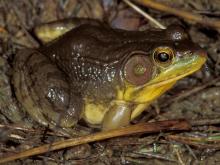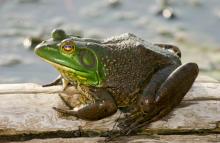Reptiles and Amphibians
Media

Species Types
Scientific Name
Apalone spinifera spinifera
Description
The eastern spiny softshell is a medium to large softshell turtle with small bumps or spines on the front edge of the upper shell. There are dark spots on the fore- and hind limbs.
Media

Species Types
Scientific Name
Lithobates clamitans (formerly Rana clamitans)
Description
The green frog looks similar to a bullfrog but is smaller and has a ridge of skin along the sides of the back that is not found on bullfrogs. It is a game animal in Missouri.
Media

Species Types
Scientific Name
Lithobates catesbeianus (formerly Rana catesbeiana)
Description
The American bullfrog is Missouri’s largest frog. This common species is easy to hear on warm nights when the males call a deep, sonorous “jug-a-rum, jug-a-rum” that can be heard from half a mile away.
Media

Species Types
Scientific Name
Kinosternon flavescens
Description
The yellow mud turtle is a small, uniformly colored, semiaquatic turtle restricted to certain counties in west-central, northeastern, and southwestern Missouri. It is an endangered species in our state.
See Also
About Reptiles and Amphibians in Missouri
Missouri’s herptiles comprise 43 amphibians and 75 reptiles. Amphibians, including salamanders, toads, and frogs, are vertebrate animals that spend at least part of their life cycle in water. They usually have moist skin, lack scales or claws, and are ectothermal (cold-blooded), so they do not produce their own body heat the way birds and mammals do. Reptiles, including turtles, lizards, and snakes, are also vertebrates, and most are ectothermal, but unlike amphibians, reptiles have dry skin with scales, the ones with legs have claws, and they do not have to live part of their lives in water.





















